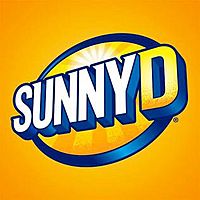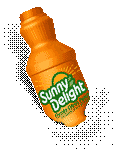SunnyD facts for kids
 |
|
| Manufacturer | Sunny Delight Beverages |
|---|---|
| Distributor | Keurig Dr Pepper (US) Saputo (Canada) |
| Introduced | 1963 |
| Color | Varies by flavor |
| Flavor | Various |
| Ingredients | Water, high fructose corn syrup, 2% or less concentrated juices |
SunnyD, also known as Sunny Delight before the year 2000, is a popular orange drink. It was first created in 1963 by a company called Doric Foods in Florida, USA. Over the years, more factories were built to make the drink.
In 1983, Sundor Brands bought Doric Foods. Then, a big company called Procter & Gamble bought Sundor Brands in 1989. SunnyD made a lot of money for Procter & Gamble. In 2005, SunnyD became its own company, called the Sunny Delight Beverages Company. Today, companies like Keurig Dr Pepper and Saputo help distribute it.
SunnyD became very popular in the United Kingdom when it launched there in 1998. It quickly became one of the top-selling soft drinks. It was sold in fridges and marketed as a healthier choice, even though it wasn't always healthier than other soft drinks.
Originally, SunnyD only came in an orange flavor. But now, you can find many different flavors! Some popular ones include Tangy Original, Smooth Orange, Orange Strawberry, and Fruit Punch. There are also flavors like Watermelon, Blue Raspberry, and Lemonade.
Contents
What's in SunnyD?
As of 2020, SunnyD in the United States has several ingredients. The main ones are water and high fructose corn syrup. It also contains a small amount (2% or less) of other things. These include citric acid and ascorbic acid, which is also known as Vitamin C.
Other ingredients help with flavor and color. These include natural flavors and different food colorings like Yellow #5 and Yellow #6. SunnyD also contains concentrated juices from fruits like orange, tangerine, apple, and pear. Some versions also use artificial sweeteners like sucralose to reduce calories.
Fun Ways SunnyD Was Promoted
The "Reach for the Sun" Game

In the mid-1990s, Sunny Delight held a cool online contest called "Reach for the Sun Bottle Hunt." They hid simple pictures of Sunny Delight bottles on different websites. These websites could be personal pages or bigger internet sites.
Each week, the main contest website gave out riddles. These riddles helped players find the hidden bottles. People were encouraged to use new search engines to help them solve the riddles.
This game first appeared in 1996 and became very popular. It was repeated three times over about a year and a half. More than 4,000 prizes were given away each time, from T-shirts to money for college. This contest was one of the first big online advertising games. It helped show how companies could use the internet to promote their products.
Try New Flavors with Peel 'n Taste
In July 2009, SunnyD teamed up with Food Lion supermarkets. They wanted to promote their new Sunny Delight Smoothies. They placed special "Peel 'n Taste" flavor samples in the store aisles. This allowed shoppers to try the new smoothie flavors right there.
Changes to the Recipe
In recent years, SunnyD has changed its recipe. They added artificial sweeteners like sucralose along with high fructose corn syrup. This change helped to lower the number of calories in the drink.
As of 2023, Sunny Delight sold in North America contains 2% or less concentrated fruit juice.
See also
 In Spanish: Sunny Delight para niños
In Spanish: Sunny Delight para niños

